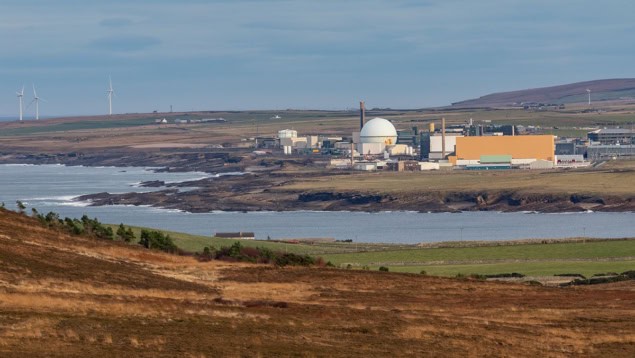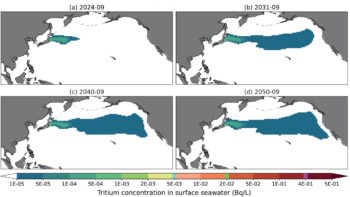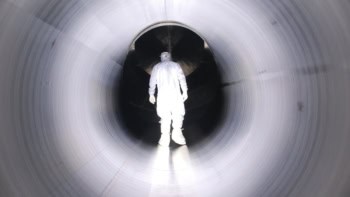PhD studentship available to develop technologies for in situ characterization of nuclear fission products

Nuclear reactors – whether operational or undergoing decommissioning – create radioactive waste. Management of this waste is a critical task and this practice has been optimized over the past few decades. Nevertheless, strategies for nuclear waste disposal employed back in the 1960s and 70s were far from ideal, and the consequences remain for today’s scientists and engineers to deal with.
In the UK, spent nuclear fuel is typically stored in ponds or water-filled silos. The water provides radiation shielding, as well as a source of cooling for the heat generated by this material. In England and Wales, the long-term disposal strategy involves ultimately transferring the waste to a deep geological disposal facility, while in Scotland, near-surface disposal is considered appropriate.
The problem, however, is that some of the legacy storage sites are many decades old and some are at risk of leaking. And when this radioactive waste leaks it can contaminate surrounding land and groundwater. The potential for radioactive contamination to get into the wet environment is an ongoing problem, particularly at legacy nuclear reactor sites.
“The strategy for waste storage 50 years ago was different to that used now. There wasn’t the same consideration for where this waste would be disposed of long term,” explains Malcolm Joyce, distinguished professor of nuclear engineering at Lancaster University. “A common assumption might have been ‘well it’s going to go in the ground at some point’ whereas actually, disposal is a necessarily rigorous, regulated and complicated programme.”
In one example, explains Joyce, radioactive waste was stored temporarily in drums and sited in near-surface spaces. “But the drums have corroded over time and they’ve started to deteriorate, putting containment at risk and requiring secondary containment protection,” he says. “Elsewhere, some of the larger ponds in which spent nuclear fuel was stored are also deteriorating and risking loss of containment.”
Problematic radioisotopes
The process of nuclear fission generates a range of radioactive products with a variety of half-lives and levels of radiotoxicity – a complex factor governed by their chemistry and radioactivity behaviours. One contaminant of particular concern is strontium-90 (Sr-90), a relatively high-yield fission product found in significant amounts in spent nuclear fuel and other radioactive waste.
Sr-90 emits relatively high-energy (0.6 MeV) beta radiation, has a relatively short half-life (about 30 years) and is water soluble, enabling it to migrate with groundwater. The major hazard, however, is its potential for uptake into biological systems. As a group 2 element similar to calcium, Sr-90 is a “bone seeker” that’s taken up by the bones and remains there, increasing the risk of leukaemia and bone cancer.
“The other challenge with strontium is that its daughter is even worse in radiotoxicity terms,” explains Joyce. Sr-90 decays into yttrium-90 (Y-90), which emits very high-energy beta radiation (2.2 MeV) that can penetrate up to 3.5 mm into aluminium. “The engineering challenge associated with Y-90 was first encountered at Three Mile Island, when they realised that the energy of the beta particles from it was sufficiently high to penetrate their personal protective equipment,” he notes.
Do not disturb
These potential biological hazards make it imperative to monitor potential radioactive contamination and address any leakages, and they also provide a basis for in situ monitoring of such leaks. One approach is to extract water or earth samples, often via boreholes, for offsite analysis in a laboratory. Unfortunately, what’s measured in the lab could be completely different to the radiological environment that you’re trying to understand. “This is an example that highlights the fact that trying to measure something actually changes the thing you’re trying to measure,” notes Joyce.
When undisturbed, Sr-90 and Y-90 reach secular equilibrium, a quiescent state in which Y-90 is produced at the same rate as its decay. Y-90 can tend to react with oxygen in the environment, dependent on pH, to form insoluble products such as yttrium oxide, known as yttria, and colloidal carbonate complexes that precipitate out of the surrounding water environment and can combine with calcium and silicon in the surrounding geology.
“There’s a steady-state radioactivity environment because it’s in secular equilibrium, and also a steady-state geochemistry environment associated with how much yttria is in suspension, settled out or stuck in the geology around it,” says Joyce. “But should it be disturbed by manual intervention this might lift plumes of material, redistributing the radioactivity in the area you’re working in. The risk associated with that is different to the risk assessments associated with the quiescent environment.”

Joyce and his team are taking a different approach, by developing a method to monitor radioactive contamination in situ. The technique exploits the bremsstrahlung radiation generated when high-energy beta particles emitted by Sr-90 and Y-90 interact with their surrounding environment and slow down. And while beta particles only travel a few millimetres before they can no longer be detected, bremsstrahlung radiation comprises far more penetrating X-ray photons that can be measured at much greater distances.
The researchers are also using an astrophysical technique to determine the distribution of the measured radioactivity. The approach uses the Moffat point spread function – developed back in 1969 to find the distribution of galaxies – to analyse the depth and spread of the contamination and, importantly, how it is changing over time.
“If the depth of these radioactive features changes, that tells you whether things are getting worse or better,” Joyce explains. “Put simply, if they’re getting nearer to the surface, that’s probably not something that you want.”
The PhD project
The team has now demonstrated that bremsstrahlung measurements can discriminate the combined Sr-90/Y-90 beta emission from gamma radiation emitted by caesium-137 (another high-yield fission product) during in situ groundwater monitoring. The next goal is to distinguish emissions from the two beta emitters.
As such, Joyce has secured funding from the UK’s Nuclear Decommissioning Authority for a PhD studentship to develop methods to detect and quantify levels of Sr-90 and Y-90 in contaminated land and aqueous environments. The project, based at Lancaster University, also aims to understand the accuracy with which the two radioisotopes can be separated and investigate their respective kinetics.
The first task will be to determine whether bremsstrahlung emissions can discriminate between these two sources of radioactive contamination. Bremsstrahlung is produced in a continuous energy spectrum, with a maximum corresponding to the maximum energy of the beta particles (which also have a continuous energy distribution). Joyce points out that, while it is quite difficult to pinpoint this maximum, it could enable deconvolution of the contributions from Sr-90 and Y-90 to the bremsstrahlung spectrum.
It may also be possible to distinguish the two radioisotopes via direct detection of the beta particles, or a completely different solution may emerge. “Never say never with a PhD,” says Joyce. “There may be a better way of doing it that we’re not aware of yet.”
Joyce emphasizes the key role that such radiation monitoring techniques could play in nuclear decommissioning projects, such as the clean-up of the Dounreay shaft, for example. The 65-m deep shaft and silo were historically used to store radioactive waste from the Dounreay nuclear reactor in Scotland. This waste now needs to be retrieved, repackaged and stored somewhere isolated from people, animals and plants.
As the facility is emptied of radioactive material, the radiological environment will change. Ideally, it will become safer, and uncertainty reduced, with any changes potentially able to inform planning. “With this new technology we’ll be able to monitor radiation levels as the programme progresses, to understand exactly what’s happening in the environment as things are being cleaned up,” explains Joyce.
“The world would be a better place as a result of the ability to make these measurements, and they could inform how similar challenges are dealt with the world over,” Joyce tells Physics World. “If you asked me ‘why should somebody do this PhD?’, altruistically, it’s about taking us closer to the point where our grandchildren don’t have to worry about these things – that’s what’s important.”
Apply now
To find out more about the PhD studentship, which is fully funded for eligible UK students, contact Malcolm Joyce at m.joyce@lancaster.ac.uk. Candidates interested in applying should send a copy of their CV together with a personal statement or covering letter addressing their background and suitability for this project before the closing date of 31 August 2024.




